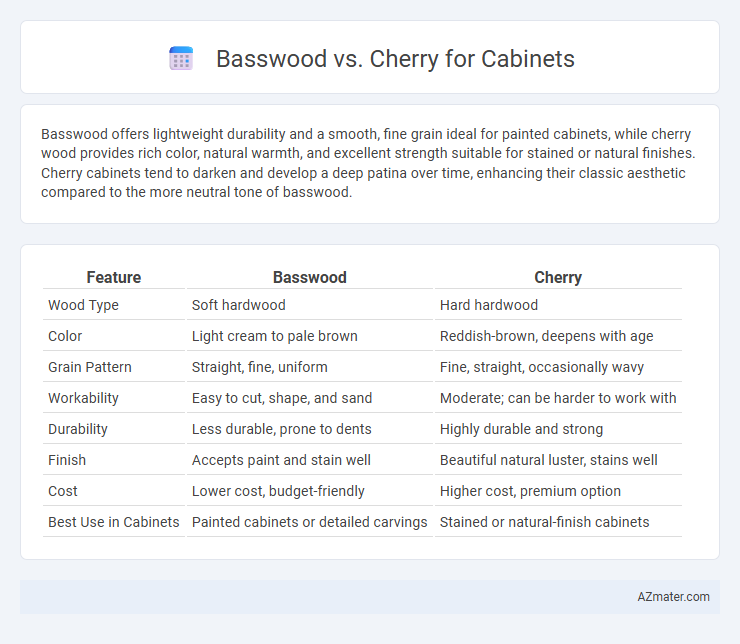Basswood offers lightweight durability and a smooth, fine grain ideal for painted cabinets, while cherry wood provides rich color, natural warmth, and excellent strength suitable for stained or natural finishes. Cherry cabinets tend to darken and develop a deep patina over time, enhancing their classic aesthetic compared to the more neutral tone of basswood.
Table of Comparison
| Feature | Basswood | Cherry |
|---|---|---|
| Wood Type | Soft hardwood | Hard hardwood |
| Color | Light cream to pale brown | Reddish-brown, deepens with age |
| Grain Pattern | Straight, fine, uniform | Fine, straight, occasionally wavy |
| Workability | Easy to cut, shape, and sand | Moderate; can be harder to work with |
| Durability | Less durable, prone to dents | Highly durable and strong |
| Finish | Accepts paint and stain well | Beautiful natural luster, stains well |
| Cost | Lower cost, budget-friendly | Higher cost, premium option |
| Best Use in Cabinets | Painted cabinets or detailed carvings | Stained or natural-finish cabinets |
Introduction to Basswood and Cherry for Cabinets
Basswood is a lightweight, fine-grained hardwood known for its smooth texture and excellent workability, making it a popular choice for cabinet interiors and painted finishes. Cherry wood, valued for its rich reddish-brown color and natural aging process, offers durability and a warm aesthetic, often preferred for high-end cabinetry. Both woods provide distinct benefits, with basswood excelling in ease of painting and cherry in elegant appearance and strength.
Key Characteristics of Basswood
Basswood is a lightweight, soft hardwood known for its fine, even texture and pale color, making it ideal for intricate carving and smooth finishes in cabinet making. Its stability and resistance to warping ensure durability in cabinet construction, while the wood's neutral tone allows for easy staining or painting to match various design styles. Unlike cherry, basswood is more affordable and less dense, providing a versatile and cost-effective option without sacrificing visual appeal.
Key Characteristics of Cherry Wood
Cherry wood is prized for its rich, reddish-brown color that deepens with age and exposure to light, offering a warm, elegant appearance ideal for cabinetry. It features a smooth, fine grain with a satiny texture, providing a luxurious finish that resists warping and moisture better than many hardwoods. Cherry wood's moderate hardness and durability make it highly suitable for cabinet construction, combining beauty with resilience.
Comparing Appearance: Basswood vs Cherry
Basswood features a pale, creamy color with a fine, uniform grain that provides a smooth, subtle appearance ideal for painted cabinets or light stains. Cherry wood offers a rich, reddish-brown hue that deepens with age and exposure to light, showcasing a distinctive, fine grain with occasional natural variations and small knots. Comparing appearance, basswood lends a neutral, soft aesthetic ideal for modern or minimalist designs, while cherry imparts warmth and elegance, perfect for traditional and classic cabinetry styles.
Durability and Strength Differences
Basswood offers moderate durability with a softer texture, making it easier to carve but less resistant to dents and scratches compared to cherry wood. Cherry wood boasts superior strength and hardness, providing excellent durability for cabinets that withstand daily wear and tear. The natural aging process of cherry also enhances its toughness, making it a preferred choice for long-lasting cabinetry.
Workability and Ease of Machining
Basswood offers superior workability and ease of machining due to its soft texture and fine, even grain, making it an ideal choice for detailed cabinet work and intricate carvings. Cherry, although harder and denser, machines well with sharp tools but requires more care to prevent burn marks and tear-out, providing a smoother finish on flat surfaces. Woodworkers often prefer basswood for projects requiring precision and detail, while cherry is chosen for its durability and rich color despite slightly increased machining effort.
Cost Comparison: Basswood vs Cherry
Basswood cabinets typically cost between $100 to $200 per board foot, making them a more budget-friendly option compared to Cherry, which ranges from $150 to $300 per board foot. The lower price of Basswood is due to its faster growth rate and abundance, while Cherry's higher cost reflects its rich color, fine grain, and durability. Choosing Basswood can significantly reduce overall cabinet expenses without sacrificing workability and smooth finishing.
Finishing and Staining Qualities
Basswood offers a smooth, even grain that absorbs stains uniformly, making it ideal for achieving consistent finishes and vibrant color results in cabinetry. Cherry wood features a rich, natural reddish hue that deepens with age, providing a warm, glowing finish without heavy staining, although it can enhance its character with light stain applications. When choosing between basswood and cherry for cabinets, consider basswood for customizable staining options and cherry for its inherently attractive tone and smooth finishing qualities.
Best Use Cases for Each Wood Type
Basswood excels in cabinetry requiring smooth, paintable surfaces and intricate carving due to its soft, uniform texture and light color, making it ideal for decorative or painted kitchen cabinets. Cherry wood offers rich, warm tones and exceptional durability, perfect for traditional or high-end cabinets where natural wood grain and aging patina enhance aesthetic appeal. Basswood suits budget-conscious projects emphasizing design detail, while cherry is best for premium, long-lasting cabinetry with a classic wood finish.
Conclusion: Choosing Between Basswood and Cherry for Cabinets
Basswood offers a lightweight, fine-grain option ideal for painted cabinetry, while cherry provides a rich, durable hardwood with a natural reddish hue suited for staining and finishing. Cherry cabinets develop a deeper patina over time, enhancing their character, whereas basswood maintains a consistent appearance, making it versatile for modern designs. The choice depends on the desired aesthetic, durability requirements, and budget, with cherry favored for high-end, long-lasting cabinetry and basswood preferred for cost-effective, smooth finishes.

Infographic: Basswood vs Cherry for Cabinet
 azmater.com
azmater.com